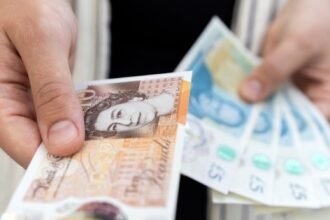GBP/USD struggles to stage a rebound and trades in a narrow channel at around 1.3350 after closing the previous four trading days in negative territory. As investors await the key September Consumer Price Index (CPI) data from the United States, which will be published on Friday, the technical outlook suggests that the bearish bias remains intact.
Pound Sterling Price This week
The table below shows the percentage change of British Pound (GBP) against listed major currencies this week. British Pound was the weakest against the New Zealand Dollar.
| USD | EUR | GBP | JPY | CAD | AUD | NZD | CHF | |
|---|---|---|---|---|---|---|---|---|
| USD | 0.62% | 0.61% | 1.39% | -0.18% | -0.33% | -0.23% | 0.74% | |
| EUR | -0.62% | 0.00% | 0.85% | -0.78% | -0.83% | -0.93% | 0.13% | |
| GBP | -0.61% | -0.00% | 0.61% | -0.79% | -0.83% | -0.94% | 0.12% | |
| JPY | -1.39% | -0.85% | -0.61% | -1.61% | -1.73% | -1.68% | -0.74% | |
| CAD | 0.18% | 0.78% | 0.79% | 1.61% | -0.10% | -0.11% | 0.91% | |
| AUD | 0.33% | 0.83% | 0.83% | 1.73% | 0.10% | -0.08% | 0.96% | |
| NZD | 0.23% | 0.93% | 0.94% | 1.68% | 0.11% | 0.08% | 1.04% | |
| CHF | -0.74% | -0.13% | -0.12% | 0.74% | -0.91% | -0.96% | -1.04% |
The heat map shows percentage changes of major currencies against each other. The base currency is picked from the left column, while the quote currency is picked from the top row. For example, if you pick the British Pound from the left column and move along the horizontal line to the US Dollar, the percentage change displayed in the box will represent GBP (base)/USD (quote).
On Wednesday, Pound Sterling came under bearish pressure after the data from the UK showed that the annual inflation, as measured by the change in the CPI, held steady at 3.8% in September. This print came in below the market expectation of 4%.
Assessing the market reaction to the UK inflation data, analysts at BBH said that the GBP dropped initially because cooler UK inflation raised Bank of England (BoE) rate cut bets but they argued that the UK’s disinflationary progress, albeit slow, reduces the risk of the economy slipping into stagflation and helps GBP/USD limit its downside.
The US economic calendar will feature Existing Home Sales data for September later in the day. Investors are unlikely to react to this data and remains focused on headlines surrounding the US-China trade conflict and the ongoing government shutdown.
GBP/USD Technical Analysis:
In the 4 hours chart, GBP/USD is currently trading around 1.3348, below the day’s opening price at 1.3351 by 3 pips, little changed on a daily basis. The intraday technical tone is soft, with spot holding beneath a descending set of moving averages: the 20-period EMA at 1.3368, the 50-period EMA at 1.3381 and the 100-period EMA at 1.3398, a bearish alignment that keeps the immediate bias tilted lower. Momentum corroborates the cautious tone as the 14-period RSI has eased to 43 from 43.6, remaining below the 50 mid-line and signaling sellers retain the upper hand without reaching oversold territory.
Initial resistance is clustered at the moving averages, with hurdles at 1.3368, 1.3381 and 1.3398; a sustained break above this band would be needed to alleviate downside pressure and refocus the 4-hour bias higher.
On the downside, the 38.2% level of trend-based Fibonacci extension aligns as the first support level at 1.3292 ahead of 1.3244 (Fibonacci 50% trend-based extension) and 1.3196-1.3200 (Fibonacci 61.8% trend-based extension, round level).
(This content was partially created with the help of an AI tool)
Pound Sterling FAQs
The Pound Sterling (GBP) is the oldest currency in the world (886 AD) and the official currency of the United Kingdom. It is the fourth most traded unit for foreign exchange (FX) in the world, accounting for 12% of all transactions, averaging $630 billion a day, according to 2022 data.
Its key trading pairs are GBP/USD, also known as ‘Cable’, which accounts for 11% of FX, GBP/JPY, or the ‘Dragon’ as it is known by traders (3%), and EUR/GBP (2%). The Pound Sterling is issued by the Bank of England (BoE).
The single most important factor influencing the value of the Pound Sterling is monetary policy decided by the Bank of England. The BoE bases its decisions on whether it has achieved its primary goal of “price stability” – a steady inflation rate of around 2%. Its primary tool for achieving this is the adjustment of interest rates.
When inflation is too high, the BoE will try to rein it in by raising interest rates, making it more expensive for people and businesses to access credit. This is generally positive for GBP, as higher interest rates make the UK a more attractive place for global investors to park their money.
When inflation falls too low it is a sign economic growth is slowing. In this scenario, the BoE will consider lowering interest rates to cheapen credit so businesses will borrow more to invest in growth-generating projects.
Data releases gauge the health of the economy and can impact the value of the Pound Sterling. Indicators such as GDP, Manufacturing and Services PMIs, and employment can all influence the direction of the GBP.
A strong economy is good for Sterling. Not only does it attract more foreign investment but it may encourage the BoE to put up interest rates, which will directly strengthen GBP. Otherwise, if economic data is weak, the Pound Sterling is likely to fall.
Another significant data release for the Pound Sterling is the Trade Balance. This indicator measures the difference between what a country earns from its exports and what it spends on imports over a given period.
If a country produces highly sought-after exports, its currency will benefit purely from the extra demand created from foreign buyers seeking to purchase these goods. Therefore, a positive net Trade Balance strengthens a currency and vice versa for a negative balance.




















